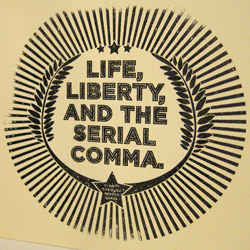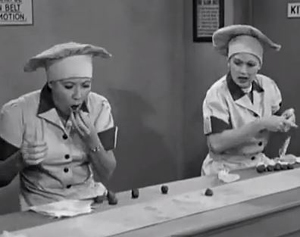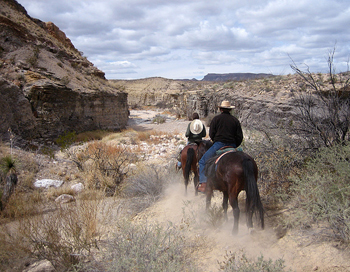
Source: Tadpole at Mystic Lake, brewbooks, Flickr
While the period is a terminator, the comma serves as a separator. This tadpole-like mark separates words, phrases, and clauses within the sentence. A comma’s primary purpose is to make sentences easier to understand by creating pauses. Consider, for instance, a sign that says, “No dogs please.” Does it mean no canines make their owners happy or please them? That was probably not what the sign writer intended. A comma after dogs clarifies the meaning. “No dogs, please” is a polite way to request that you leave the pooch at home.
As you put the finishing touches on your assignments, you insert commas because they are conventions required in academic English. When you edit for commas, your attention is on individual sentences. One technique that may help you develop a laser-like focus on internal punctuation is to read the last sentence of your paper first and then continue backward sentence-by-sentence to the beginning. As you do so, keep an eye out for these common instances where commas are needed.
- Did you add commas after the city and state?
Most writers know to include the comma between the city and state but often overlook the comma after the state name. - Did you add a comma after the complete date?
A complete date (consisting of a month, date, and year) requires a comma after the day and the year. Most writers remember the comma after the day but forget the comma after the year. Perhaps it will help you remember to add the last comma after the year if you think about years being interruptions in the sentence to add more specific information. We use the comma after the year to signal that we've completed our interruption and we're going back into the sentence.
- Did you include all the commas in a series?
Commas are used when you list things in a series. One comma that gets overlooked is the serial comma (also known as the Oxford comma). Use it immediately before a coordinating conjunction that precedes the final item in a list of three or more items. In many sentences, this last comma helps prevent ambiguity, so it’s often the preferred way to punctuate a list or series. - Did you use a comma to separate an introductory expression from the rest of the sentence?
- Did you use a comma to separate a direct address?
- Did you use a comma to separate two independent clauses in compound sentences?
- Did you use a comma to separate an introductory phrase or clause from the rest of the sentence?
- Did you use a pair of commas to set off interruptions?
- Did you set off a quotation with a comma?
Houston, Texas, has bragging rights.

Source: Life, Liberty, and the Serial Comma, Aaron Kraus, Flickr.
On December 29, 1845, Texas became a state.
She took a photograph of her parents, the president, and the vice president.
In this sentence, there are four people in the series. Without the serial comma, there are only two: her parents, who were also the president and the vice president.
Sadly, I missed your birthday.

Source: Lucy and Ethel in the chocolate factory, screenshot of video, IPSI
Ethel, did you tell Lucy to eat all those chocolates?
Clauses are groups of words with subjects and predicates. If a sentence contains two independent clauses linked by a coordinating conjunction (and, or, but, for, nor, so, or yet), there is a comma before the conjunction.
This spring I attended the Texas Crawfish Festival, and the Cajun cuisine gave me indigestion.
However, do not use a comma before a coordinator that links two words or phrases:
A Texan and an Oklahoman were out riding horses and roping cattle.

Source: into the canyon, Eltjo Poort, Flickr
Even in bad weather, the Texan saddled up his horse and rode out on the range.
If you set off an interruption with one comma, of course, you must add the second comma.
Jerry Seinfeld observed, “Having a two-year old is kind of like having a blender, but you don’t have a top for it.”
Now that you have reviewed some of the primary rules for using commas, proofread the sentences below. If the sentence is correctly punctuated, click on “correct.” If a comma is missing or incorrectly placed, click on “incorrect.”

1. Dolly walked on her head, a little higher than usual.
2. Dolly, David and Danielle reminded us that their parents liked names that start with “D.”
3. Both Dolly and David like red and black licorice.
4. The restaurant served kale chips, but I asked for potato chips instead.
5. That’s another fine mess you’ve gotten us into Stanley.
6. On December 26, 2012 I went on a shopping spree.
7. Because I have perfect attendance, I will get a coupon for a free pizza.
8. The huge city of Houston, Texas, is home to millions of people.
9. Unfortunately we live in a complicated world.
10. The first thing Sam did when he came home was to let the dog out.